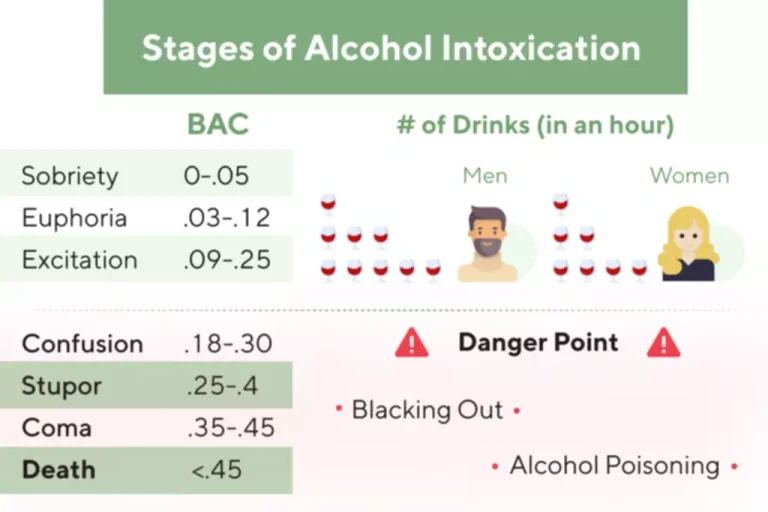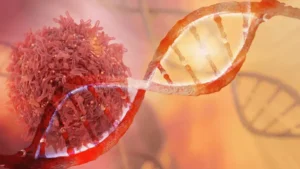
But depending on things like age, weight, metabolism, and general health, this might change. The effects of alcohol also depend on the user’s tolerance level and the quantity ingested. An individual who consumes alcohol at a modest dose may experience drunkenness for several hours. It’s crucial to remember that even after the initial effects of alcohol may wear off, a person may still experience long-term damage to their cognitive and motor abilities. Also referred to as blood alcohol content/level, blood alcohol concentration (BAC) refers to the percentage of alcohol in a person’s bloodstream. For example, a BAC of .10% indicates that the individual’s blood contains one part alcohol for every 1,000 parts of blood.

What’s the outlook for alcohol intoxication?

Alcohol withdrawal symptoms range from mild but annoying to severe and life-threatening. As you look at how alcoholism begins and the stages in which alcoholism develops, you’ll then see something called end stage alcoholism. On average, the liver can metabolize 1 ounce of alcohol every hour.
Alcoholism: When Does It Start?

Blacking out from drinking too much is a warning sign of this stage, along with lying about drinking, drinking excessively, and thinking obsessively about drinking. American Addiction Centers (AAC) is committed to delivering original, truthful, accurate, unbiased, and medically current information. We strive to create content that is clear, concise, and easy to understand. stages of alcohol impairment A person can usually tell when they are intoxicated, but it may be challenging to spot the signs in others. The Department of Health and Human Services classifies alcohol as a carcinogen, a substance that plays a role in causing cancer. The medical community has linked alcohol with numerous types of cancer, such as cancers of the mouth, larynx, and esophagus.
Alcohol poisoning vs. being drunk
As individuals continue to drink alcohol over time, progressive changes may occur in the structure and function of their brains. These changes can compromise brain function and drive the transition from controlled, occasional use to chronic misuse, which can be difficult to control. The changes can endure long after a person stops consuming alcohol, and can contribute to relapse in drinking. New research has found that psilocybin reduces alcohol consumption in rats by altering the left nucleus accumbens in the brain. Most recently, real-world human studies have been very positive in reporting decreases in drinking for diabetic patients treated with GLP-1s (think Ozempic and Wegovy).

Alcoholism was identified in 1956 as an illness by the American Medical Association (AMA). It’s a disease—an altering of the brain that controls a person’s motivation and ability to make healthy choices. Once it takes hold, it can be hard to shake loose—without the right help.
What is the Outlook for Alcohol Intoxication?
These symptoms can lead someone to drink more to relieve withdrawal symptoms. Because denial is common, you may feel like you don’t have a problem with drinking. You might not recognize how much you drink or how many problems in your life are related to alcohol use. Listen to relatives, friends or co-workers when they ask you to examine your drinking habits or to seek help.

They may appear to maintain coordination and motor skills to some degree. A person with a higher tolerance may not look intoxicated, despite drinking a large amount of alcohol. Others who have had less to drink may look more intoxicated than a person with a high tolerance. Many factors affect alcohol tolerance, including a person’s biochemistry, race, ethnicity, body mass and how an individual consumes alcohol. The National Institute of Alcohol Abuse and Alcoholism (NIAAA) encourages medical providers to screen patients for alcohol consumption and initiate interventions aimed at harm reduction.
Alcohol Intoxication: What You Should Know
Drivers with a BAC of 0.08 or more are 11 times more likely to be killed in a single-vehicle crash than non-drinking drivers. Some states have higher penalties for people who drive with high BAC (0.15 to 0.20 or above) due to the increased risk of fatal accidents. Showing signs of alcohol intoxication and taking other substances, such as drugs or medication, in addition to the alcohol. They are best for people who have a high motivation to recover and cannot leave their responsibilities at home, work, or school. Outpatient programs are often part of aftercare programs once you complete an inpatient or PHP program.
- Her work spans various health-related topics, including mental health, fitness, nutrition, and wellness.
- Alcoholism emerges from alcohol abuse, when there’s a pattern of drinking despite negative consequences.
- From there, you will work on maintenance (learning to live sober) and, finally, transcendence or full recovery.
- If you’re in the “at-risk” population, it doesn’t take much to become dependent on alcohol or other drugs.
Once detox is complete, alcoholics can begin tackling problematic behaviors related to their addiction and learn how to live sober again. Because alcoholism is a chronic disease and alcohol relapse is common, persistence is a necessity — but success is achievable. Cirrhosis can cause a host of other health problems, including high blood pressure, which can lead to the development of enlarged veins in the esophagus called esophageal varices. These are similar to the varicose veins that some people develop in their legs. But esophageal varices are prone to rupture, and when they do, the alcoholic can bleed to death. Later, it can cause fatigue, bleeding and bruising, itchy skin, yellow discoloration of the skin and eyes and fluid accumulation in the abdomen known as ascites.

